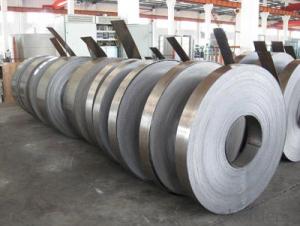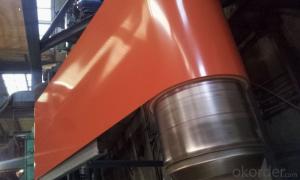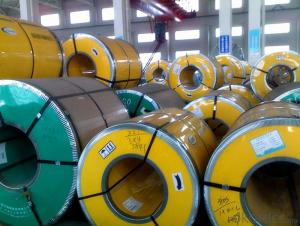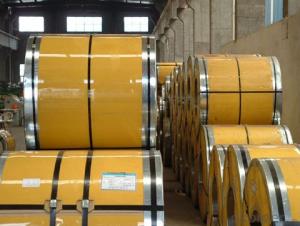Galvanized Steel Strip with High Quality-SGCC 680*1.0mm
- Loading Port:
- China main port
- Payment Terms:
- TT OR LC
- Min Order Qty:
- 50 m.t
- Supply Capability:
- 10000 m.t/month
OKorder Service Pledge
OKorder Financial Service
You Might Also Like
Galvanized Steel Strip with High Quality-SGCC 680*1.0mm
Product Description:
Specifications:
Thickness: 1.0mm
Width: 680mm
Material: SGCC
ID: 508mm or 610mm
Spangle: Regular spangle or zero spangle
others: chromated or no chromated; oiled or no oiled.
Advantages of Galvanized Steel Strip with High Quality-SGCC 680*1.0mm:
1. Uniform coating;
2. Strong adhesion;
3. Strong corrosion resistant ability
Usage of Galvanized Steel Strip with High Quality-SGCC 680*1.0mm:
1. Making pipes, like Greenhouse tubes, drinking water pipe, heating pipe, gas pipe and so on;
2. Used in automobile;
3. Used in construction;
4. Used in agriculture, fishery and so on.
FAQ of Galvanized Steel Strip with High Quality-SGCC 680*1.0mm:
Q1: How soon can we receive the product after purchasement?
A1: Within three days of placing an order, we will begin production. The specific shipping date is dependent upon international and government factors, but is typically one month-two months.
Q2: How do you guarantee the quality of our products?
A2: We have established an advanced quality management system which conducts strict quality tests at every step, from raw materials to the final product. At the same time, we provide extensive follow-up service assurances as required.
Q3: The prices are invoicing on theoritical weight or on actual weight?
A3: We can do it in both manners, according to the customers' request.
Images of Galvanized Steel Strip with High Quality-SGCC 680*1.0mm:
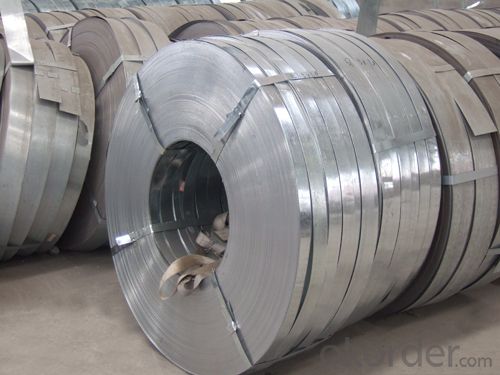
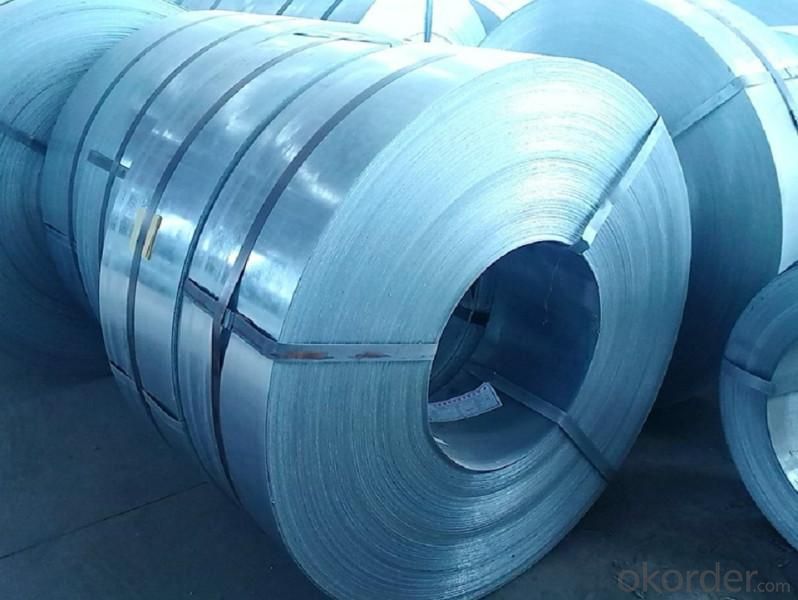
*If you would like to get our price, please kindly inform us the standard/material, specifications and quantity. Thank you very much for your attention.
- Q:What are the different heat treatment processes used for steel strips?
- Some of the different heat treatment processes used for steel strips include annealing, quenching and tempering, normalization, and hardening and tempering.
- Q:How are steel strips heat-treated for specific applications?
- Steel strips are heat-treated for specific applications using a process called annealing. Annealing involves heating the steel strips to a specific temperature, holding it at that temperature for a certain period of time, and then slowly cooling it down. The purpose of this heat treatment is to enhance the properties of the steel strips to meet the specific requirements of the application. The first step in heat-treating steel strips is heating them to a temperature above their critical transformation temperature. This temperature can vary depending on the type of steel and its composition. Heating the steel strips above this temperature allows for the complete dissolution of any impurities or other elements present in the structure of the steel. Once the steel strips reach the desired temperature, they are held at that temperature for a specific period of time. This holding time is crucial as it allows for the desired changes to occur within the structure of the steel. During this time, the carbon atoms in the steel diffuse, resulting in the formation of a more uniform and stable microstructure. After the holding time, the steel strips are slowly cooled down. The cooling rate is carefully controlled to prevent the formation of undesirable structures and to ensure the desired properties are achieved. This slow cooling process, also known as quenching, helps in reducing the internal stresses and increasing the ductility and toughness of the steel strips. The heat treatment process can be further tailored to specific applications by introducing additional steps such as tempering or hardening. Tempering involves reheating the steel strips to a lower temperature and then cooling it down again. This process helps in reducing the brittleness of the steel strips and improving their toughness. On the other hand, hardening involves quenching the steel strips in a rapid cooling medium such as oil or water. This process results in the formation of a hardened structure with increased hardness and wear resistance. In conclusion, steel strips are heat-treated for specific applications through a process called annealing. This process involves heating the steel strips to a specific temperature, holding them at that temperature, and then slowly cooling them down. By carefully controlling the heat treatment parameters, the desired microstructure and properties can be achieved to meet the specific requirements of the application.
- Q:How do steel strips contribute to the strength of structures?
- Steel strips contribute to the strength of structures by providing structural support and reinforcement. They are often used in construction to increase the load-bearing capacity of beams, columns, and other structural elements. The high tensile strength and durability of steel make it an ideal material for withstanding heavy loads and resisting bending or warping. Additionally, steel strips can be strategically placed in specific areas of a structure to enhance its overall stability and prevent failure under stress or extreme conditions.
- Q:What are the different types of stamping or forming processes for steel strips?
- Steel strips can be manipulated into different shapes and sizes using various stamping or forming processes. These processes are employed to achieve the desired end product. Some commonly used stamping or forming processes for steel strips are as follows: 1. Blanking: This involves cutting the steel strip into a specific shape or pattern using a die. Blanking is typically used for creating smaller parts or components. 2. Bending: By deforming the steel strip, a desired angle or curve can be achieved. This can be done using a press brake or other bending machines. 3. Deep drawing: This process is used to create complex shapes or forms from a flat steel strip. The strip is placed over a die and pressed into the die cavity to create the desired shape. 4. Roll forming: A continuous process where a steel strip passes through a series of rollers to gradually shape it into a specific profile. This method is commonly employed for creating long, continuous sections like metal roofing or building panels. 5. Embossing: This process involves creating raised or recessed patterns on the surface of a steel strip. A die or roller with the desired pattern is utilized for this purpose. 6. Coining: By compressing a steel strip between two dies, a specific shape or pattern can be created. This method is often utilized to add intricate designs or details to the surface of the strip. Each of these stamping or forming processes offers distinct advantages and is suitable for different applications. The choice of process depends on factors such as the desired end product, the complexity of the shape, and the production requirements.
- Q:Can steel strips be used for making utensils?
- Yes, steel strips can be used for making utensils.
- Q:What are the factors that affect the thermal conductivity of steel strips?
- There are several factors that can affect the thermal conductivity of steel strips. 1. Composition: The chemical composition of the steel strip plays a significant role in determining its thermal conductivity. Different types of steel alloys have different thermal conductivities. For example, carbon steel generally has lower thermal conductivity compared to stainless steel. 2. Temperature: The thermal conductivity of steel strips can vary with temperature. In general, the thermal conductivity of metals tends to decrease as the temperature increases. However, this relationship can be influenced by other factors such as alloy composition and impurities. 3. Microstructure: The microstructure of the steel strip, including the arrangement of atoms and crystal defects, can impact its thermal conductivity. For instance, a more uniform and compact microstructure is likely to have higher thermal conductivity compared to a microstructure with impurities or defects. 4. Grain size: The grain size of the steel strip can affect its thermal conductivity. Finer grain sizes tend to enhance thermal conductivity, as they provide a more continuous path for heat transfer throughout the material. 5. Impurities: The presence of impurities, such as sulfur or phosphorus, can reduce the thermal conductivity of steel strips. These impurities can act as barriers to heat transfer, hindering the flow of thermal energy through the material. 6. Surface finish: The surface finish of the steel strip can impact its thermal conductivity. A smooth surface finish allows for better contact and heat transfer between the strip and other objects it comes into contact with, resulting in higher thermal conductivity. 7. Thickness: The thickness of the steel strip can also affect its thermal conductivity. Thicker strips tend to have lower thermal conductivity due to the increased distance heat has to travel through the material. 8. Heat treatment: The heat treatment process used on the steel strip can alter its thermal conductivity. Different heat treatment methods can modify the microstructure and overall thermal properties of the steel, thus affecting its thermal conductivity. It is important to consider these factors when selecting and utilizing steel strips for applications that require specific thermal conductivity properties.
- Q:What are the specifications for steel strips used in the production of springs for firearms?
- The specifications for steel strips used in the production of springs for firearms vary depending on the specific requirements of the firearm manufacturer and the intended use of the springs. However, there are some common specifications that are generally followed in the industry. 1. Material: The steel strips used for springs in firearms are typically made from high carbon or alloy steels. These steels are chosen for their strength, durability, and ability to withstand the recoil forces generated by the firearm. 2. Hardness: The hardness of the steel strips is an important specification as it directly affects the spring's ability to resist deformation and maintain its shape under load. The hardness is usually specified in terms of Rockwell hardness (HRC) or Brinell hardness (HB) and is typically in the range of 45-55 HRC or 450-550 HB. 3. Thickness: The thickness of the steel strips is determined based on the required strength and flexibility of the spring. Thinner strips are generally used for lighter springs, while thicker strips are used for heavier springs. The thickness can range from a few hundredths of an inch to a few tenths of an inch, depending on the specific application. 4. Width: The width of the steel strips is another important specification, as it determines the overall size and shape of the spring. The width is typically chosen to match the design requirements of the firearm and can range from a fraction of an inch to several inches. 5. Surface Finish: The surface finish of the steel strips is often specified to ensure smooth operation and reduce friction between the spring and other components. Common surface finishes include polished, ground, or coated finishes. 6. Tensile Strength: The tensile strength of the steel strips is a measure of its ability to resist breaking under tension. It is usually specified in terms of the ultimate tensile strength (UTS) and is typically in the range of 130,000-200,000 psi (pounds per square inch). 7. Yield Strength: The yield strength of the steel strips is a measure of its ability to resist permanent deformation under load. It is typically specified as a percentage of the UTS and is usually around 75-85% of the UTS. These specifications ensure that the steel strips used in the production of springs for firearms are strong, durable, and able to withstand the harsh operating conditions of firearms. They also ensure that the springs function reliably and consistently, contributing to the overall performance and safety of the firearm.
- Q:How are steel strips used in the production of metal enclosures?
- Steel strips are an essential component in the production of metal enclosures due to their versatility and strength. These strips are typically made from a high-quality steel alloy, such as stainless steel or galvanized steel, which provides excellent durability and resistance to corrosion. In the manufacturing process, steel strips are first cut into specific lengths and widths, depending on the dimensions of the metal enclosure being produced. These strips are then shaped and formed into the desired shape using various techniques, such as bending, folding, or welding. The steel strips serve as the main structural component of the metal enclosure, providing stability and rigidity to the overall structure. They are often used to create the frame or skeleton of the enclosure, acting as support for other components and ensuring that the enclosure maintains its shape and integrity. Moreover, steel strips are also used to create panels or walls of the enclosure. These panels are usually attached to the frame using welding or fastening methods, creating a solid and secure structure. The steel strips can be perforated or have holes to allow for ventilation or cable management, depending on the specific requirements of the enclosure. Additionally, steel strips can be coated or painted to enhance their appearance and provide additional protection against rust or other environmental factors. This allows the metal enclosures to be used in various industries, including electronics, telecommunications, and automotive, where aesthetics and durability are crucial. Overall, steel strips play a vital role in the production of metal enclosures by providing strength, stability, and versatility. They are an integral part of the manufacturing process, ensuring that the final product meets the required standards and provides a reliable and durable solution for housing various equipment and components.
- Q:How do steel strips contribute to electrical conductivity in various applications?
- Steel strips can contribute to electrical conductivity in various applications due to their high electrical conductivity properties. Steel, being a metal, has a large number of free electrons that are able to move freely within its structure. This allows for the efficient flow of electric current through the steel strips. In the context of electrical applications, steel strips are widely used in the manufacturing of electrical conductors such as wires and cables. The high electrical conductivity of steel strips ensures that the electric current can easily pass through them with minimal resistance, resulting in efficient transmission of electrical power. Additionally, steel strips are often employed in the construction of electrical generators and transformers. These devices rely on the movement of magnetic fields to generate electricity or transform voltage levels. Steel strips, due to their magnetic properties, help in enhancing the efficiency of these devices by providing a low reluctance path for the magnetic flux, thereby improving the overall electrical conductivity. Moreover, steel strips find applications in electrical grounding systems. Grounding is crucial for electrical safety as it helps to divert excess electrical energy to the ground, preventing damage to equipment and minimizing the risk of electric shock. Steel strips used in grounding systems provide a low resistance path for the flow of fault currents, ensuring effective grounding and electrical conductivity. In summary, steel strips contribute to electrical conductivity in various applications by offering high electrical conductivity, enabling efficient transmission of electrical power, enhancing the performance of electrical generators and transformers, and providing effective grounding solutions.
- Q:What is the price of steel strips?
- The price of steel strips can vary depending on factors such as the grade of steel, market demand, and supplier. It is best to contact specific manufacturers or suppliers to get accurate pricing information.
1. Manufacturer Overview |
|
|---|---|
| Location | |
| Year Established | |
| Annual Output Value | |
| Main Markets | |
| Company Certifications | |
2. Manufacturer Certificates |
|
|---|---|
| a) Certification Name | |
| Range | |
| Reference | |
| Validity Period | |
3. Manufacturer Capability |
|
|---|---|
| a)Trade Capacity | |
| Nearest Port | |
| Export Percentage | |
| No.of Employees in Trade Department | |
| Language Spoken: | |
| b)Factory Information | |
| Factory Size: | |
| No. of Production Lines | |
| Contract Manufacturing | |
| Product Price Range | |
Send your message to us
Galvanized Steel Strip with High Quality-SGCC 680*1.0mm
- Loading Port:
- China main port
- Payment Terms:
- TT OR LC
- Min Order Qty:
- 50 m.t
- Supply Capability:
- 10000 m.t/month
OKorder Service Pledge
OKorder Financial Service
Similar products
New products
Hot products
Related keywords
